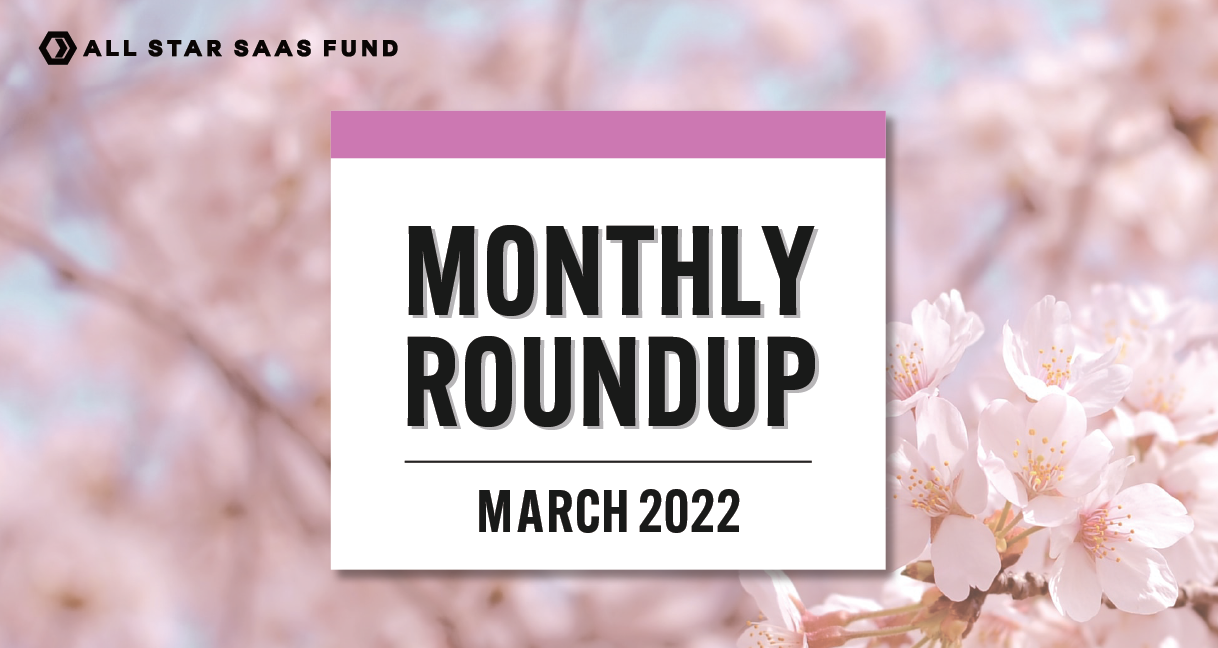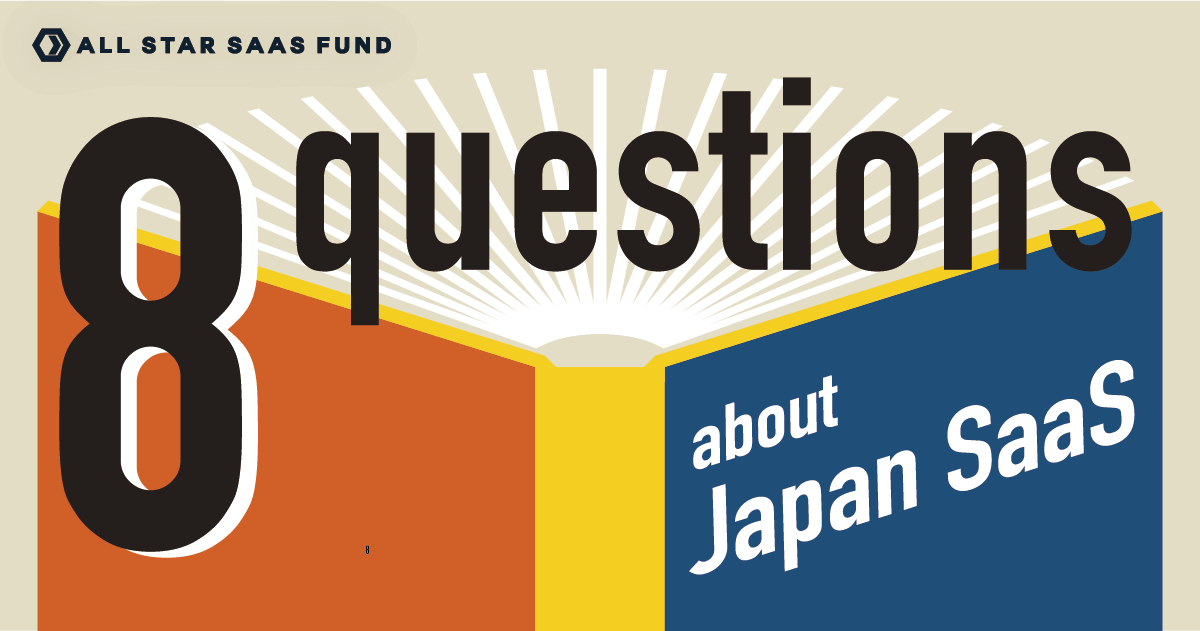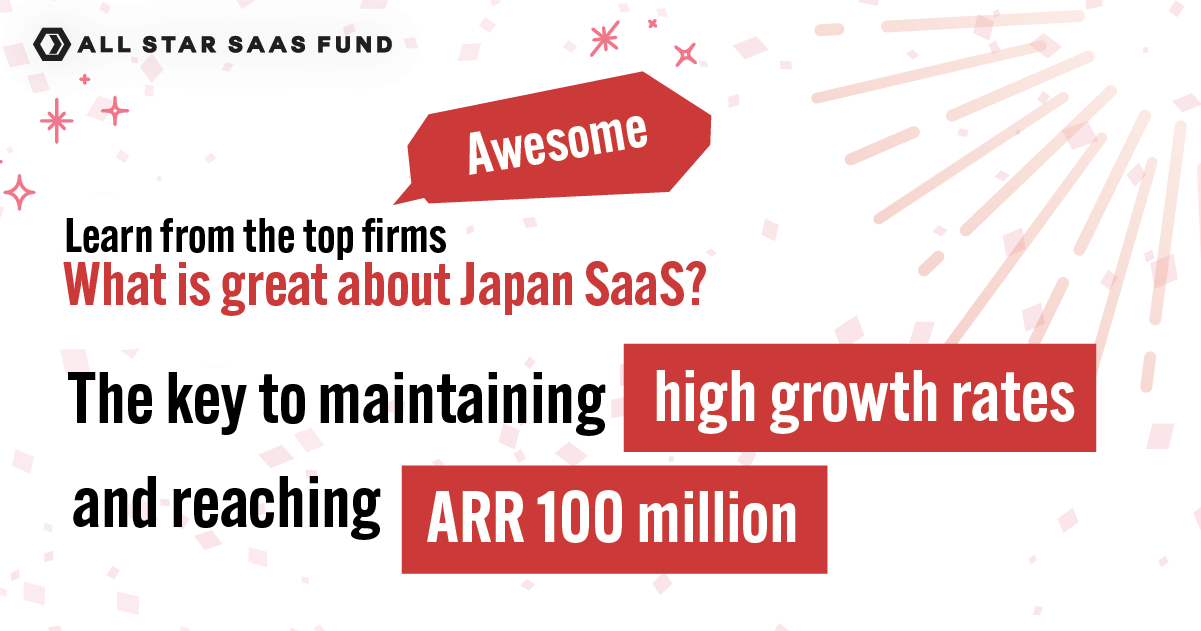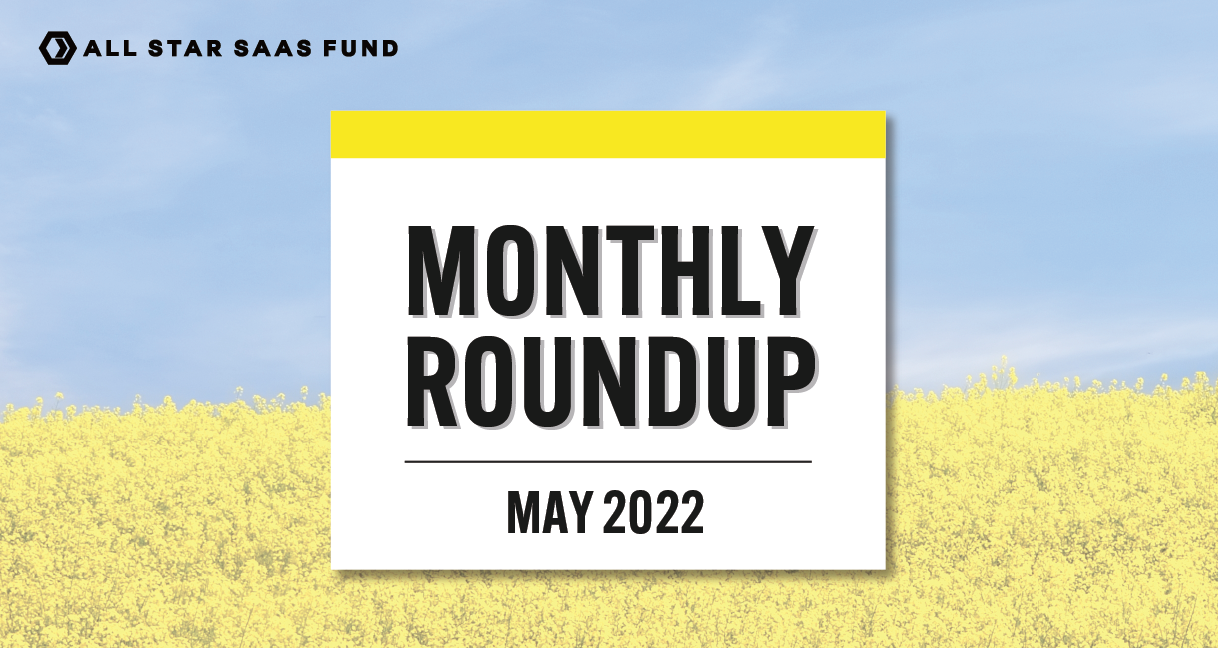8 Questions about Japan SaaS
SaaS is growing at an explosive rate.

Welcome to the first edition of ALL STAR SAAS FUND Monthly Roundup - a monthly series where we invite various team members to share their observations around Japan SaaS!
In this month’s roundup, Hiro, Masa and Tatsuya discuss the current market environment and key considerations when evaluating Japan SaaS companies.
Here’s a couple of interesting highlights from their discussion, which you can also watch here (in Japanese).
As a fast-growing SaaS market, Japan has no shortage of successful companies that have made it big in their own verticals. But when it comes to market valuation, investors are often concerned with who are the true market leaders that have the potential to eventually shape the industry.
Hiro shares that the most straightforward method is by comparing a company’s size against its competitors.
Very often, a company’s growth rate is highly correlated with its Price-to-Sales ratio (PSR). For instance, if you look at market capitalization of Japanese SaaS companies, those with Annual Recurring Revenue (ARR) of over $100 million and 25% annual growth rate have a median PSR of 13.7. However, the median PSR for all Japanese SaaS companies is just 5.9, so there is an obvious difference between the high-growth companies and everyone else.
Large companies which can maintain annual growth rates of 25% and above are also likely to be addressing a larger Total Addressable Market (TAM), compared to its competitors. As a result, these companies with large sales figures and huge growth potential tend to be more attractive to investors, and can be viewed as market leaders.
Going public is never an easy decision to make. While it is entirely up to the company to decide when it is best to go public, Hiro shares two benchmarks that could be useful: achieving ARR $100 million or 25% annual growth rate.
This is because SaaS services tend to gain more leverage as they grow bigger in size. Compare an ARR $100 million company with $30 million to spend on sales and marketing against an ARR $10 million company with only $3 million to spend; as you can imagine, the ARR $100 million company is able to enjoy far greater economies of scale in sales, marketing, R&D etc. versus its smaller competitor.
Interestingly, Masa observes that while a growth rate of above 25% and ARR $100 million is the bare minimum for companies to go public in the US, it is not yet the norm for Japanese SaaS companies.
Another observation shared by Masa is that there are plenty of individual investors within the Japanese market, and these investors tend to evaluate companies by considering whether they can reap profits in the short run. This leads to a fundamental question of which is more important for startups: profits or growth?
For companies around the ARR $100 million and 25% growth rate benchmark, investors are likely to value long term growth potential instead of short term returns.
But for startups with a smaller market capitalization, individual investors tend to form a larger part of the investor bench and are naturally more interested in short term profitability. This would then affect the timing which these companies choose to IPO.
From Hiro’s point of view, this is a path which startup founders should avoid. Even if it seems like investors favour profitable companies that IPO with a smaller market capitalization, startup founders should still aim to capture an overwhelming share of the market and be in a position to leverage large economies of scale.
Therefore, it is also essential for companies to work with investors and shareholders that believe in the same strategy.
While there are Japanese SaaS companies experiencing accelerated growth now, such as B2B cloud service Money Forward which achieved over ARR $120 million and 38% annual growth and enterprise cloud Rakus with a 5 year plan to reach ARR $448 million by March 2026 (as shown below), many other SaaS startups and smaller companies continue to display low growth rates.
Source: Money Forward Inc. Financial Results Briefing for the Fiscal Year ended November 2021

Source: RAKUS Co. Ltd 2022年3月期決算説明資料
Hiro shares some possible reasons why:
The timing that companies go public
Based on recent figures, US companies tend to IPO at around ARR $300 to $400 million, which also implies that they have sufficient funds to invest in growing the company, building up their products etc. This will give them a huge advantage in keeping growth numbers high.
On the other hand, Japanese companies could IPO at around ARR $40 million, which means that they have less resources to invest in their products and sales strategy etc.
Differences in competitive environment
The Japanese market is also comparatively less competitive than the US market. For instance, a company could face up to 10 competitors in the US but a similar company is likely to only have 1 to 2 competitors in Japan. As a result, there is a sense of urgency to constantly stay ahead of the competition in the US - and this urgency is not yet present in Japan.
However, it is important to also keep in mind the long term potential of these companies and dive deeper into how investors can help them maximise their growth in the long run.
When thinking about long term growth, many startups often deliberate over whether they should develop single or multiple products. While product diversification is definitely something to consider as part of a company’s blueprint, it would require plenty of work and coordination across multiple business units and is not a strategy suited for every company.
At an early stage, Hiro notes that launching multiple products could lead to lack of focus. Companies could find themselves drowning in a barrage of multiple customer voices and lose sight of what are the key product features to build. This would lead to further complexities in the product development process and cause the company to lose its chance to build strong foundations.
What is more important is for each company to find the correct Product Market Fit and create a successful Go-to-Market strategy.

When should companies start thinking about making new products and services?
|
I guess it really comes down to a case by case situation. For myself, I think that spreading yourself too thin leads to slightly slower growth. I know that I shouldn’t generalise, but in the Japanese market, we don’t really see a big segment of early adapters. This leads to companies starting to slow down after getting to around ARR $1 million and it sometimes requires up to 3 years to get to Product Market Fit. This is why I think that companies should start early to gradually develop secondary products. Only starting when you have ARR $3 million would pose problems because you’d be raising quite big sums of capital and facing a lot of pressure to grow. This means a lot of effort needs to be placed on sales and service expansion as companies need to start justifying their PSR multiple number. Therefore, starting early does help! But just be aware that this cannot and should not be generalised.
|

If you have a product that isn’t really getting the traction you want it to and you have identified the issues that are impeding growth, is it important to increase the traction of this product?
Or is it better to try to release a second product as soon as possible?
Tatsuya, Partner
|
This is a very difficult question. But what’s important is that without doing both you won’t really be able to scale rapidly. I mean, numbers aren’t everything, but to maintain a strong growth rate, both need to be done. It's also often hard to define what “traction” means for a product, so the questions that you should ask are what are the segments that your product fits with right now? What are the next segments that you need to aim for and what are their traits? What are the differences? Digging deep into these questions is very important. If there is lack of awareness, then general promotion campaigns will solve the traction issue. If it is a sales issue, then tweaking your marketing strategy or appearing at trade shows for lead generation may be the solution. However, it might be a case where it’s not a problem of sales and marketing, but the product is missing a very needed function. In that case, developing a second product and investing in it may allow you to reach a new segment. |
|
Indeed! Well, if I myself were in this situation, I would first check the churn rate of the first product. A gross churn rate of below 1% for SMCs (small medium companies) or below 0.5% for mid-size and larger companies is the benchmark here. If your metrics pass this test, then something is actually going well and there must be some form of a market fit. In this case, any issues you face may be with operations or sales. If you improve on these areas, you’d probably see improvements in traction too. If you have not reached this though, there’s probably something off about the product, in which case focusing on the second product or pivoting the first product may be needed. But yes, I would look at your churn rate. |

SaaS is growing at an explosive rate.

US inflation fears, and an economic downturn from the possible raising of interest rates. These factors have led to headwinds that have caused market...

Psst…Have you heard of the Burn Multiple?